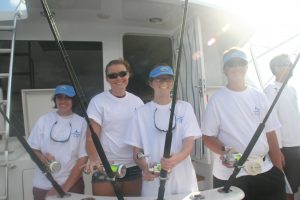The University of Miami R.J. Dunlap Marine Conservation Program (RJD) has joined forces with The Billfish Foundation (TBF) to develop a billfish tagging program for high school students that will educate, invigorate, and create conservation-minded anglers, ultimately providing research opportunities.
This new and exciting program will provide RJD students with the opportunity to spend time on the water with world-renown captains and anglers who will show them the techniques needed to successfully catch sailfish safely.
Last month off Lighthouse Point, FL students from South Broward Marine Magnet high school had a phenomenal time fishing offshore (some for the first time) and having the opportunity to participate in billfish research. Not only did the students learn about the biological and economic importance of sportfishing locally and internationally; they were able to release 4 sailfish, tagging two of them – adding to the world’s largest private billfish tagging database that provides vital data about the species. And billfish weren’t the only fish they saw; the students also saw a great hammerhead, kingfish and a number of dolphin.
The trip was such a success that TBF and RJD are already planning more billfishing trips for 2012!
2
replies
Leave a Reply
Want to join the discussion?Feel free to contribute!
Leave a Reply
Privacy Statement and Legal Notices
Copyright © 2018, University of Miami
All rights reserved.
4600 Rickenbacker Causeway
Miami, Fl 33149-1098
+1 305 421 4000




what is the name of fish at your last pic?
Hemingway in Cuba – The Sea and Marlin Fishing
By Matthew Barker
The sea and marlin fishing were the first incentives Hemingway had to travel to Cuba after his friend Joe Russell invited him to fish marlins in the waters of the Gulf of Mexico, where, it is said, Hemingway captured almost 20 specimens. From that moment on, marlin fishing became his life obsession. With his first yacht, named Anita, he began his first crossings north from Havana up to the surrounding areas of Levisa Key in Pinar del Rio.
Already living in the Vigía Farmhouse, he used to drive his car dressed in his Cuban guayabera, his moccasin shoes and drinking his rum while heading north to Cojimar, a fishing town near Havana where his yacht Pilar was docked (the yacht can be seen today in the Vigía Farmhouse Museum) and where lived the master of his yacht and friend, Gregorio Fuentes. Together, they pursued the adventure of capturing the largest and most challenging fish. It is said that once he hooked a fish of 750 pounds, which broke his fishing rod after half an hour of battling. This was the challenge he searched for every time he sailed, and captured so well in his novel “The Old Man and the Sea”; a novel that earned him the Nobel Prize of Literature in 1954.
Outside of fishing season, Hemingway used to sail aimlessly, spending days camping on deserted keys and scuba diving in the coralline paradises of the Cuban coasts. During World War II, Hemingway, with his wife and master Gregorio, used to patrol the coast in search of German submarines on his yacht Pilar. Once detected, Hemingway informed the American authorities in Havana or Key West about the German moves. He loved fishing so much that he became the promoter of a fishing contest that today is called the “Ernest Hemingway International Marlin Fishing Tournament”, of which the headquarters are located in the Cuban marina named after the great writer, in Jaimanitas, west of Havana City. It was during one of these tournaments that the writer met Fidel Castro. Sunday May 15, 1960 they sailed: Hemingway on his yacht Pilar and Fidel on the Yacht Crystal, accompanied by Che Guevara. When the day came to an end, Fidel and Hemingway met on the docks in order to compare their fish; however, the conversation quickly turned to literature and the social reality that the Revolution wanted to change. This was the first of many encounters.
The Hemingway Tournament has been held 60 times, every May, continuing the tradition initiated by the novelist. The tournament follows the IGFA rules and the participating teams can be up to four fishermen using the “Tag and Release” technique. The fishing line allowed is of 50 pounds. The tournament offers three first places, an award to the first capture and another to the greatest capture of the contest. If you are interested, you can sail with your own yacht or rent one at the Hemingway Marina, which includes the crew and fishing tackles. This page was created by http://www.pyrimed.com/services